人教版(2019)必修第二册Unit 4 History and Traditions Reading and Thinking(共33张PPT,内镶嵌视频)
文档属性
| 名称 | 人教版(2019)必修第二册Unit 4 History and Traditions Reading and Thinking(共33张PPT,内镶嵌视频) | 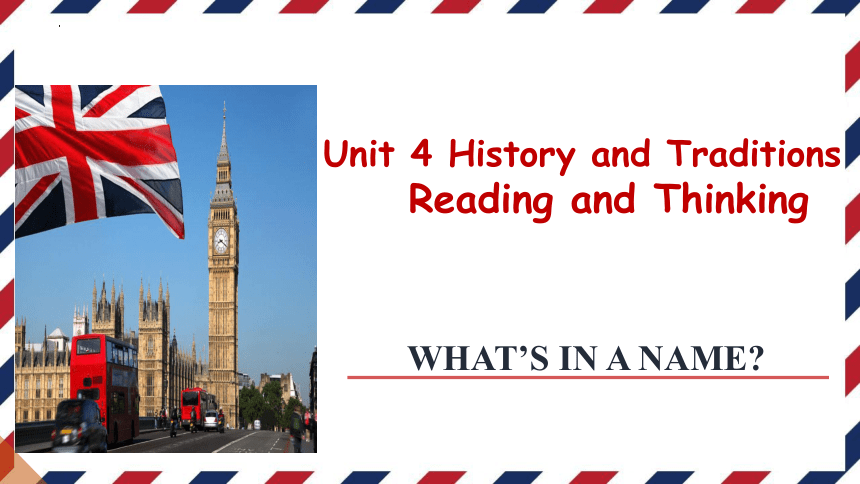 | |
| 格式 | pptx | ||
| 文件大小 | 36.9MB | ||
| 资源类型 | 教案 | ||
| 版本资源 | 人教版(2019) | ||
| 科目 | 英语 | ||
| 更新时间 | 2024-04-05 21:12:03 | ||
图片预览

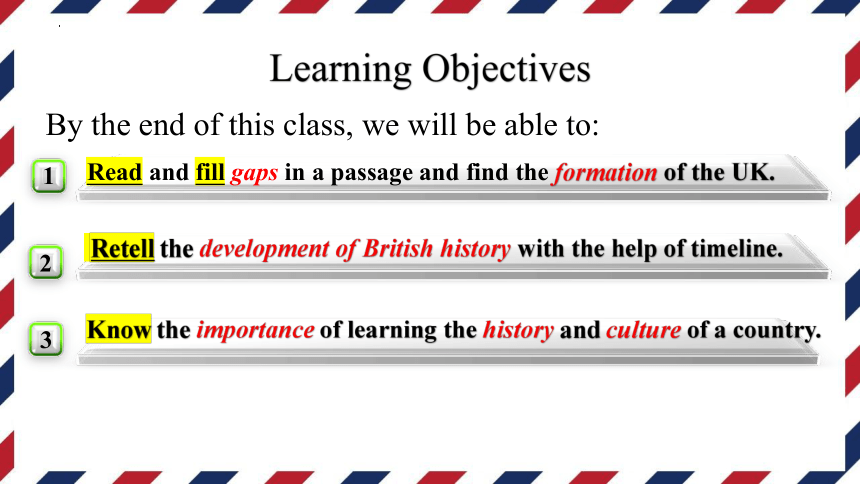
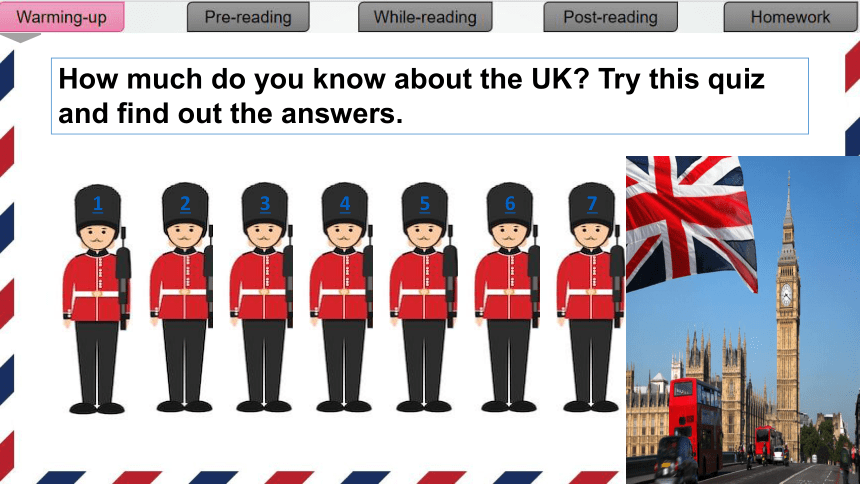
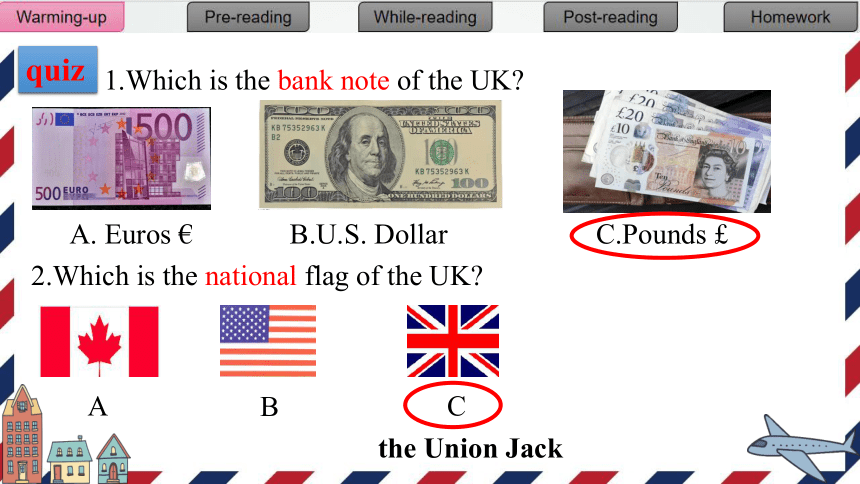
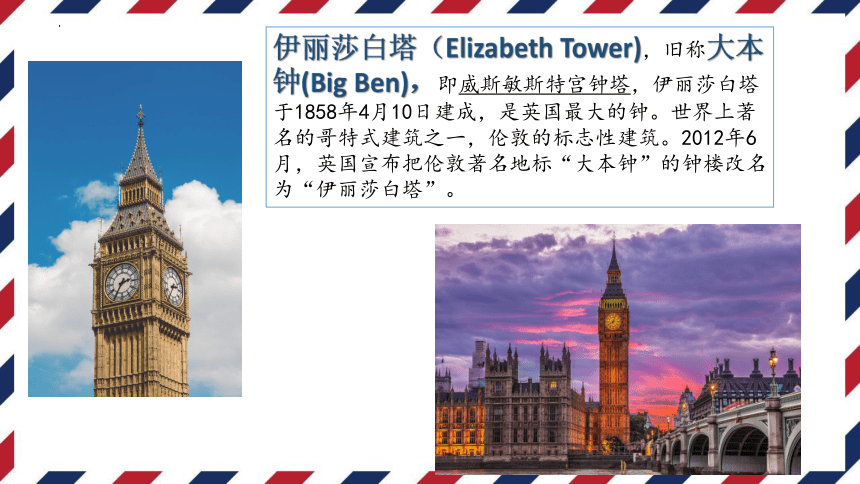
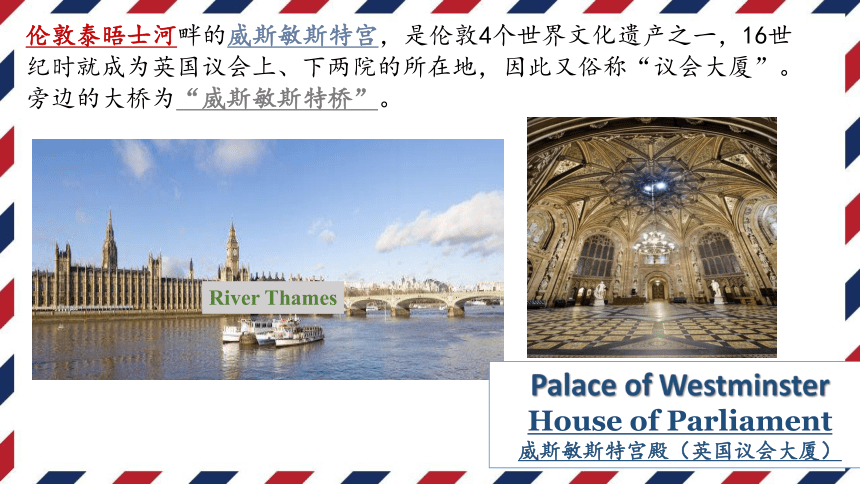
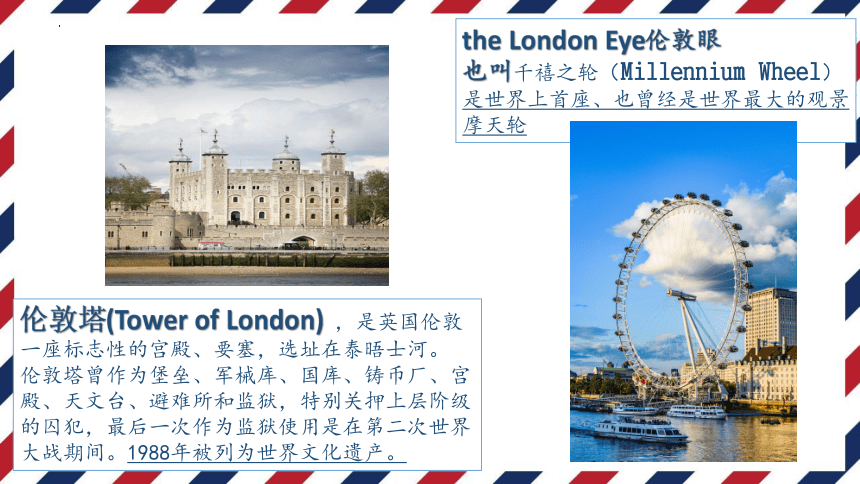
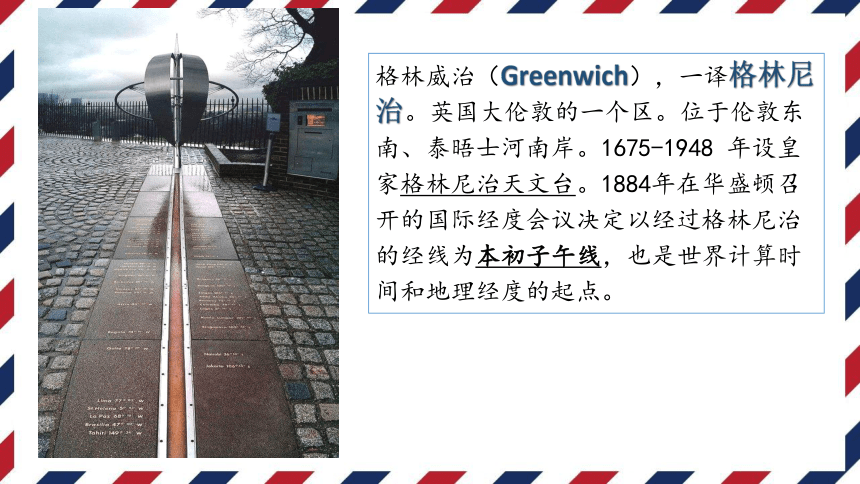
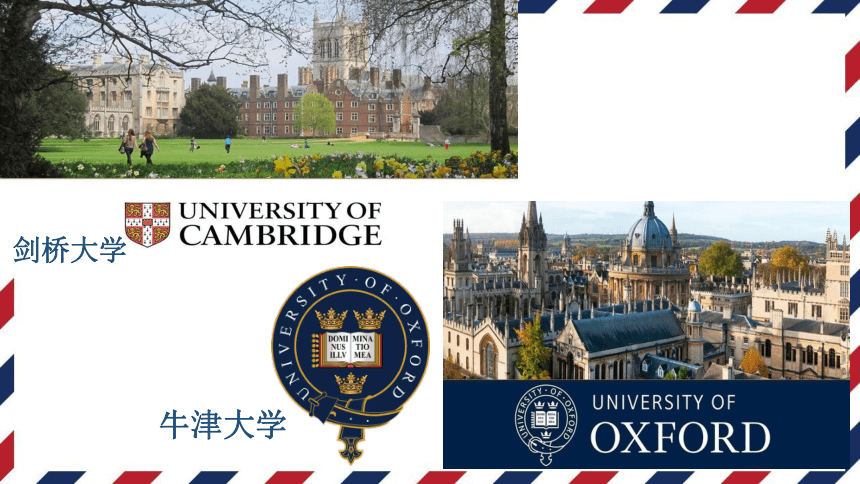
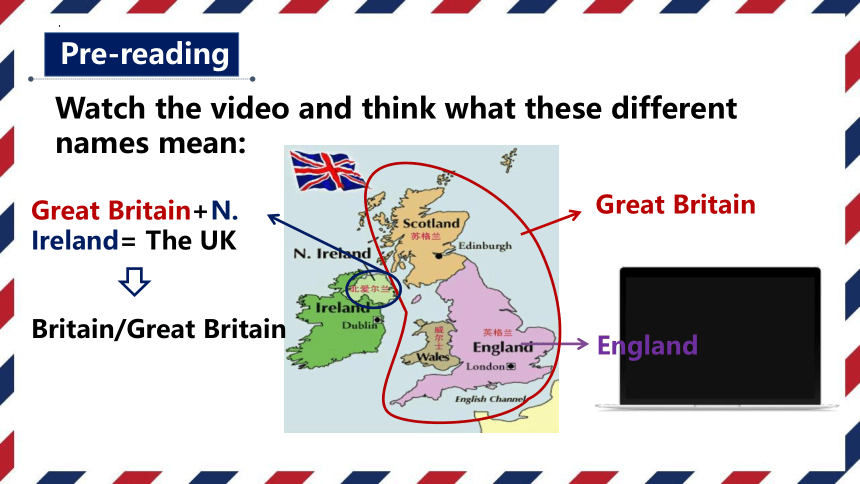
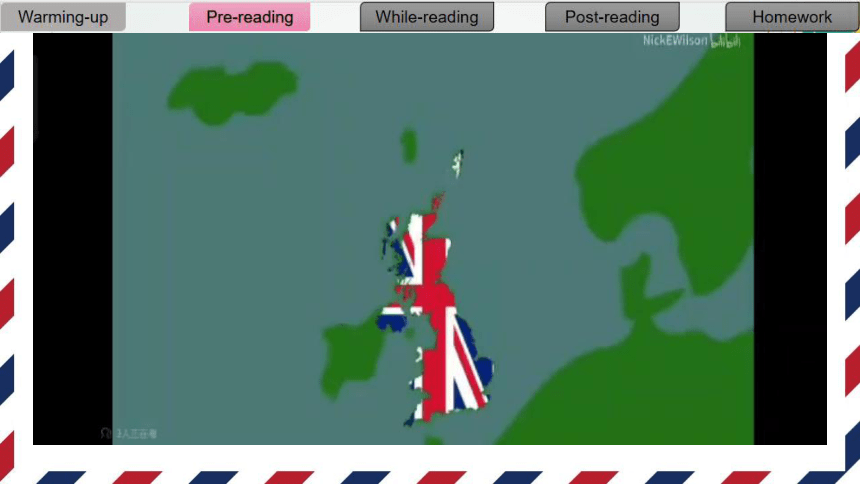
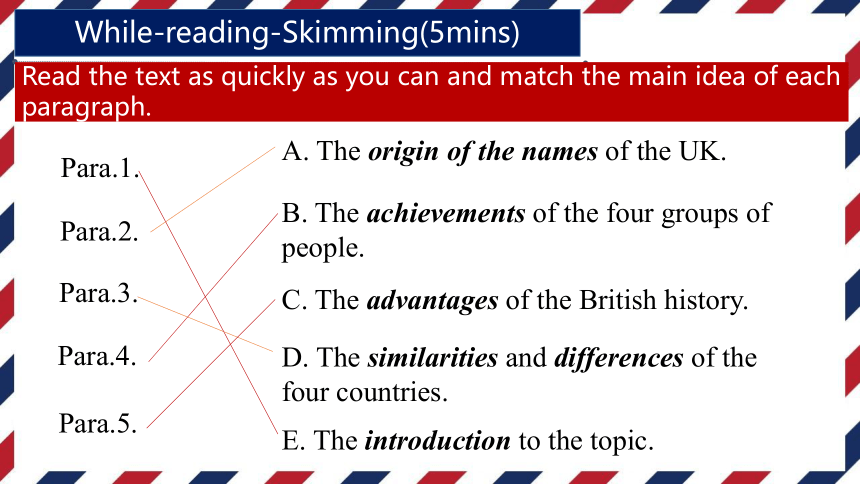
文档简介
(共33张PPT)
Unit 4 History and Traditions
Reading and Thinking
WHAT’S IN A NAME
Learning Objectives
Read and fill gaps in a passage and find the formation of the UK.
Know the importance of learning the history and culture of a country.
Retell the development of British history with the help of timeline.
2
1
3
By the end of this class, we will be able to:
How much do you know about the UK Try this quiz and find out the answers.
1
2
3
4
5
6
7
quiz
2.Which is the national flag of the UK
A
B
C
1.Which is the bank note of the UK
A. Euros ?
B.U.S. Dollar
C.Pounds
the Union Jack
伊丽莎白塔(Elizabeth Tower),旧称大本钟(Big Ben),即威斯敏斯特宫钟塔,伊丽莎白塔于1858年4月10日建成,是英国最大的钟。世界上著名的哥特式建筑之一,伦敦的标志性建筑。2012年6月,英国宣布把伦敦著名地标“大本钟”的钟楼改名为“伊丽莎白塔”。
伦敦泰晤士河畔的威斯敏斯特宫,是伦敦4个世界文化遗产之一,16世纪时就成为英国议会上、下两院的所在地,因此又俗称“议会大厦”。旁边的大桥为“威斯敏斯特桥”。
Palace of Westminster
House of Parliament
威斯敏斯特宫殿(英国议会大厦)
River Thames
the London Eye伦敦眼
也叫千禧之轮(Millennium Wheel)是世界上首座、也曾经是世界最大的观景摩天轮
伦敦塔(Tower of London) ,是英国伦敦一座标志性的宫殿、要塞,选址在泰晤士河。
伦敦塔曾作为堡垒、军械库、国库、铸币厂、宫殿、天文台、避难所和监狱,特别关押上层阶级的囚犯,最后一次作为监狱使用是在第二次世界大战期间。1988年被列为世界文化遗产。
格林威治(Greenwich),一译格林尼治。英国大伦敦的一个区。位于伦敦东南、泰晤士河南岸。1675-1948 年设皇家格林尼治天文台。1884年在华盛顿召开的国际经度会议决定以经过格林尼治的经线为本初子午线,也是世界计算时间和地理经度的起点。
剑桥大学
牛津大学
Pre-reading
Watch the video and think what these different names mean:
England
Great Britain
Great Britain+N. Ireland= The UK
Britain/Great Britain
While-reading-Skimming(5mins)
Para.1.
Para.2.
Para.3.
Para.4.
Para.5.
A. The origin of the names of the UK.
B. The achievements of the four groups of people.
C. The advantages of the British history.
D. The similarities and differences of the four countries.
E. The introduction to the topic.
Read the text as quickly as you can and match the main idea of each paragraph.
The United Kingdom, Great Britain, Britain, England—many people are confused by what these different names mean. So what is the difference between them, if any Getting to know a little bit about British history will help you solve this puzzle.
British history
Question:
1. What does “this puzzle” mean in the sentence
2. What can we do to help solve the puzzle
What will be talked about next
time ? space ? logic?
Para.1
Para.1: A puzzle concerning the name
Para.2: The four names of the country
Listen to the tape and circle the time number
16th century
18th century
19th century
20th century
the Kingdom
of England
the Kingdom
of Great Britain
the United
Kingdom of
Great Britain
and Ireland
the United
Kingdom of
Great Britain
and Northern
Ireland
the United
Kingdom
the UK
England
+Wales
England
+Wales
+Scotland
Great Britain
+Ireland
Great Britain
+Northern Ireland
Work in groups and finish the timeline
England
Wales
Scotland
Northern Ireland
What similarities and differences do the four countries have
The four countries that belong to the United Kingdom work together in some areas. They use the same flag, known as the Union Jack, as well as share the same currency and military defence. However, they also have some differences. For example, England, Wales, Scotland, and Northern Ireland all have different education systems and Legal systems.They also have their own traditions, like their own national days and national dishes.And they even have their own football teams for competitions like the World Cup!
work together
have some differences
However
Similarities
Differences
education systems and Legal systems
traditions( national days and dishes)
football teams
Para.3: the similarities and differences among the four countries within the UK.
There were 4 groups of people once conquered the UK.
Do you know
who are they
when they arrived
what they changed
Para.4: Four Groups of people in UK’s history
The United Kingdom has a long and interesting history to explore, which can help you understand much more about the country and its traditions. Almost everywhere you go in the UK, you will be surrounded by evidence of four different groups of people who took over at different times throughout history. The first group, the Romans, came in the first century. Some of their great achievements included building towns and roads. Next, the Anglo-Saxons arrived in the fifth century. They introduced the beginnings of the English language, and changed the way people built houses. The Vikings came in the eighth century, left behind lots of new vocabulary, and also the names of many locations across the UK. The last group were the Normans. They conquered England after the well-known Battle of Hastings in the 11th century. They had castles built all around England, and made changes to the legal system. The Normans were French, so many French words slowly entered into the English language.
There were 4 groups of people once conquered the UK.
Do you know who are they
C. Anglo-Saxons
B. Romans
D. Normans
A. Vikings
Para.4: Four Groups of people in UK’s history
the first group
the second group
the third group
the fourth group
When What happened What changed
Romans arrived built town and roads
Anglo-Saxons came
Vikings came
11th century
1st century
5th century
8th century
conquered
England after the Battle of Hastings
Complete the table below with information from Para4.
Four groups of people brought different cultures to the country.
introduced English
changed the way people built
left behind lots of new
left the names of many
built
made changes to the
entered into English language
Normans
language
houses
vocabularies
locations
castles
legal system
French words
There is so much more to learn about the interesting history and culture of the United Kingdom. Studying the history of the country will make your visit much more enjoyable. The capital city London is a great place to start, as it is an ancient port city that has a history dating all the way back to Roman times. There are countless historic sites to explore, and lots of museums with ancient relics from all over the UK. The UK is a fascinating mix of history and modern culture, with both new and old traditions. If you keep you eyes open, you will be surprised to find that you can see both its past and its present.
Q: 1. What’s the importance of studying history
2. Why is London a great place to start
Para.5: The importance of studying history
If you keep your eyes open, you will be surprised to find that you can see both its past and its present.
Q1 : Who does the word “you” refer to
A. scientists B. visitors
C. parents D. exchange students
Q2 : What’s the writing purpose of writing this passage
A. to introduce the history of the UK for visitors
B. to share his travel experience with others
C. to tell us how to travel around the world
D. to show how travel can change the world
1.How many stages did it go through to form the name:the United Kingdom of
Great Britain and Norther Ireland
A. Three. B. Two. C. Four. D. Five.
2.What do the four countries share
A. Currency, flag and military defence.
B. Football team, flag and legal system.
C. Education system, flag and military defence.
D. Currency, legal system and education system.
4.Based on the text, what are the advantages of studying the history of a country
A.To help you understand more about the country .
B.To help you understand its traditions.
C.To make visiting it more enjoyable .
D.All the above.
细节理解题
细节理解题
推断判断题
3.What does the word “conquered” in Paragraph 4 mean
A. joined. B. defeated. C. lost to. D. gave in to.
词义推断题
Summary
When What happened What changed
Romans arrived towns and roads
Ango-Saxons came language and the way building house
Vikings came
11th century
16th century
18th century
19th century
20th century name changed to “United Kingdom of Great Britain and Northern Ireland”
1st century
5th century
8th century
Normans conquered England after the Battle of Hastings
Wales was joined to Kingdom of England
Scotland was joined to England and Wales
Ireland was added
the southern part of Ireland broke away
castles built, legal system changed,
and new words from French introduced
“Kingdom of Great Britain” formed
“United Kingdom of Great Britain and Ireland” formed
vocabulary and names of locations across the UK
Read again and finish the timeline chart. --Group work(9mins)
Read P2 and P4 again to complete the timeline:
20th century
11th century
16th century
18th century
19th century
Romans arrived
Anglo-Saxons came
Vikings came
1st century
5th century
8th century
Normans came
Wales
was
joined
Scotland
was
joined
Ireland was added
Southern Ireland broke away
Summary
Post-reading(15mins)
The United Kingdom, Great Britain,Britain,England- many people________(confuse) by what these different names mean, ________(get) to know a little bit about British history will help you solve the puzzle. From the 16th century to the 19th century,Wales, Scotland and the Kingdom of lreland were joined ________( create) the United Kingdom of Great Britain and lreland. In the 20th century, the southern part of lreland broke away________the UK, ________resulted in the full name:the United Kingdom of Great Britain and Northern lreland. The four countries that belong________the UK work together in some areas. However, they also have some________ ( different).Almost everywhere you go in the UK,you will be surround by evidence of four different groups of people________took over at different times. There is so much more to learn about ________interesting history and culture of the United Kingdom. Studying the history of the country will make your visit much more________(enjoy).
Activity1:Fill in the blanks(5mins)
getting
are confused
to cerat
from
which
to
differences
who
the
enjoyable
Is it necessary for visitors to study the history and culture of a country before visiting it Why
Discussion
It will help us .
understand the place better and have a more enjoyable experience
communicate better with people about their history and cultures and have a richer experience
The United Kingdom or the UK ________(make) up of four countries. They are England, Wales, Scotland and Northern Ireland. It has________ interesting and long history. Everywhere you go in the country, you will be surrounded ________evidence of four different groups of people who took over at different times throughout history. The Romans, ________achievements included building towns and roads, came first in the first century. Then in the fifth century arrived Anglo Saxons who introduced the beginnings of English language and changed the way people built houses.
is made
an
by
whose
Summary
The Vikings came in the eighth century. They left behind lots of new vocabulary and also the names of many____________(location) across the UK. The last group, the Normans__________ (conquer) England in the 11th century. They had castles ________(build) all around there. The Normans were in fact French, so many French words ________(slow) entered into the English language.
The UK is a ____________(fascinate) mix of history and modern culture. If you keep eyes open, you will be surprised ________(find) that you can see both its past and present.
locations
conquered
built
slowly
fascinating
to find
A people without the knowledge of their past history, origin and culture is like a tree without roots.
—Marcus Garvey
一个不了解自己历史、起源和文化的民族,就如同一棵无根之树.
We should not only learn the knowledge of our past history and spread our culture, but respect other cultures and learn from each other.
Thank you !
Unit 4 History and Traditions
Reading and Thinking
WHAT’S IN A NAME
Learning Objectives
Read and fill gaps in a passage and find the formation of the UK.
Know the importance of learning the history and culture of a country.
Retell the development of British history with the help of timeline.
2
1
3
By the end of this class, we will be able to:
How much do you know about the UK Try this quiz and find out the answers.
1
2
3
4
5
6
7
quiz
2.Which is the national flag of the UK
A
B
C
1.Which is the bank note of the UK
A. Euros ?
B.U.S. Dollar
C.Pounds
the Union Jack
伊丽莎白塔(Elizabeth Tower),旧称大本钟(Big Ben),即威斯敏斯特宫钟塔,伊丽莎白塔于1858年4月10日建成,是英国最大的钟。世界上著名的哥特式建筑之一,伦敦的标志性建筑。2012年6月,英国宣布把伦敦著名地标“大本钟”的钟楼改名为“伊丽莎白塔”。
伦敦泰晤士河畔的威斯敏斯特宫,是伦敦4个世界文化遗产之一,16世纪时就成为英国议会上、下两院的所在地,因此又俗称“议会大厦”。旁边的大桥为“威斯敏斯特桥”。
Palace of Westminster
House of Parliament
威斯敏斯特宫殿(英国议会大厦)
River Thames
the London Eye伦敦眼
也叫千禧之轮(Millennium Wheel)是世界上首座、也曾经是世界最大的观景摩天轮
伦敦塔(Tower of London) ,是英国伦敦一座标志性的宫殿、要塞,选址在泰晤士河。
伦敦塔曾作为堡垒、军械库、国库、铸币厂、宫殿、天文台、避难所和监狱,特别关押上层阶级的囚犯,最后一次作为监狱使用是在第二次世界大战期间。1988年被列为世界文化遗产。
格林威治(Greenwich),一译格林尼治。英国大伦敦的一个区。位于伦敦东南、泰晤士河南岸。1675-1948 年设皇家格林尼治天文台。1884年在华盛顿召开的国际经度会议决定以经过格林尼治的经线为本初子午线,也是世界计算时间和地理经度的起点。
剑桥大学
牛津大学
Pre-reading
Watch the video and think what these different names mean:
England
Great Britain
Great Britain+N. Ireland= The UK
Britain/Great Britain
While-reading-Skimming(5mins)
Para.1.
Para.2.
Para.3.
Para.4.
Para.5.
A. The origin of the names of the UK.
B. The achievements of the four groups of people.
C. The advantages of the British history.
D. The similarities and differences of the four countries.
E. The introduction to the topic.
Read the text as quickly as you can and match the main idea of each paragraph.
The United Kingdom, Great Britain, Britain, England—many people are confused by what these different names mean. So what is the difference between them, if any Getting to know a little bit about British history will help you solve this puzzle.
British history
Question:
1. What does “this puzzle” mean in the sentence
2. What can we do to help solve the puzzle
What will be talked about next
time ? space ? logic?
Para.1
Para.1: A puzzle concerning the name
Para.2: The four names of the country
Listen to the tape and circle the time number
16th century
18th century
19th century
20th century
the Kingdom
of England
the Kingdom
of Great Britain
the United
Kingdom of
Great Britain
and Ireland
the United
Kingdom of
Great Britain
and Northern
Ireland
the United
Kingdom
the UK
England
+Wales
England
+Wales
+Scotland
Great Britain
+Ireland
Great Britain
+Northern Ireland
Work in groups and finish the timeline
England
Wales
Scotland
Northern Ireland
What similarities and differences do the four countries have
The four countries that belong to the United Kingdom work together in some areas. They use the same flag, known as the Union Jack, as well as share the same currency and military defence. However, they also have some differences. For example, England, Wales, Scotland, and Northern Ireland all have different education systems and Legal systems.They also have their own traditions, like their own national days and national dishes.And they even have their own football teams for competitions like the World Cup!
work together
have some differences
However
Similarities
Differences
education systems and Legal systems
traditions( national days and dishes)
football teams
Para.3: the similarities and differences among the four countries within the UK.
There were 4 groups of people once conquered the UK.
Do you know
who are they
when they arrived
what they changed
Para.4: Four Groups of people in UK’s history
The United Kingdom has a long and interesting history to explore, which can help you understand much more about the country and its traditions. Almost everywhere you go in the UK, you will be surrounded by evidence of four different groups of people who took over at different times throughout history. The first group, the Romans, came in the first century. Some of their great achievements included building towns and roads. Next, the Anglo-Saxons arrived in the fifth century. They introduced the beginnings of the English language, and changed the way people built houses. The Vikings came in the eighth century, left behind lots of new vocabulary, and also the names of many locations across the UK. The last group were the Normans. They conquered England after the well-known Battle of Hastings in the 11th century. They had castles built all around England, and made changes to the legal system. The Normans were French, so many French words slowly entered into the English language.
There were 4 groups of people once conquered the UK.
Do you know who are they
C. Anglo-Saxons
B. Romans
D. Normans
A. Vikings
Para.4: Four Groups of people in UK’s history
the first group
the second group
the third group
the fourth group
When What happened What changed
Romans arrived built town and roads
Anglo-Saxons came
Vikings came
11th century
1st century
5th century
8th century
conquered
England after the Battle of Hastings
Complete the table below with information from Para4.
Four groups of people brought different cultures to the country.
introduced English
changed the way people built
left behind lots of new
left the names of many
built
made changes to the
entered into English language
Normans
language
houses
vocabularies
locations
castles
legal system
French words
There is so much more to learn about the interesting history and culture of the United Kingdom. Studying the history of the country will make your visit much more enjoyable. The capital city London is a great place to start, as it is an ancient port city that has a history dating all the way back to Roman times. There are countless historic sites to explore, and lots of museums with ancient relics from all over the UK. The UK is a fascinating mix of history and modern culture, with both new and old traditions. If you keep you eyes open, you will be surprised to find that you can see both its past and its present.
Q: 1. What’s the importance of studying history
2. Why is London a great place to start
Para.5: The importance of studying history
If you keep your eyes open, you will be surprised to find that you can see both its past and its present.
Q1 : Who does the word “you” refer to
A. scientists B. visitors
C. parents D. exchange students
Q2 : What’s the writing purpose of writing this passage
A. to introduce the history of the UK for visitors
B. to share his travel experience with others
C. to tell us how to travel around the world
D. to show how travel can change the world
1.How many stages did it go through to form the name:the United Kingdom of
Great Britain and Norther Ireland
A. Three. B. Two. C. Four. D. Five.
2.What do the four countries share
A. Currency, flag and military defence.
B. Football team, flag and legal system.
C. Education system, flag and military defence.
D. Currency, legal system and education system.
4.Based on the text, what are the advantages of studying the history of a country
A.To help you understand more about the country .
B.To help you understand its traditions.
C.To make visiting it more enjoyable .
D.All the above.
细节理解题
细节理解题
推断判断题
3.What does the word “conquered” in Paragraph 4 mean
A. joined. B. defeated. C. lost to. D. gave in to.
词义推断题
Summary
When What happened What changed
Romans arrived towns and roads
Ango-Saxons came language and the way building house
Vikings came
11th century
16th century
18th century
19th century
20th century name changed to “United Kingdom of Great Britain and Northern Ireland”
1st century
5th century
8th century
Normans conquered England after the Battle of Hastings
Wales was joined to Kingdom of England
Scotland was joined to England and Wales
Ireland was added
the southern part of Ireland broke away
castles built, legal system changed,
and new words from French introduced
“Kingdom of Great Britain” formed
“United Kingdom of Great Britain and Ireland” formed
vocabulary and names of locations across the UK
Read again and finish the timeline chart. --Group work(9mins)
Read P2 and P4 again to complete the timeline:
20th century
11th century
16th century
18th century
19th century
Romans arrived
Anglo-Saxons came
Vikings came
1st century
5th century
8th century
Normans came
Wales
was
joined
Scotland
was
joined
Ireland was added
Southern Ireland broke away
Summary
Post-reading(15mins)
The United Kingdom, Great Britain,Britain,England- many people________(confuse) by what these different names mean, ________(get) to know a little bit about British history will help you solve the puzzle. From the 16th century to the 19th century,Wales, Scotland and the Kingdom of lreland were joined ________( create) the United Kingdom of Great Britain and lreland. In the 20th century, the southern part of lreland broke away________the UK, ________resulted in the full name:the United Kingdom of Great Britain and Northern lreland. The four countries that belong________the UK work together in some areas. However, they also have some________ ( different).Almost everywhere you go in the UK,you will be surround by evidence of four different groups of people________took over at different times. There is so much more to learn about ________interesting history and culture of the United Kingdom. Studying the history of the country will make your visit much more________(enjoy).
Activity1:Fill in the blanks(5mins)
getting
are confused
to cerat
from
which
to
differences
who
the
enjoyable
Is it necessary for visitors to study the history and culture of a country before visiting it Why
Discussion
It will help us .
understand the place better and have a more enjoyable experience
communicate better with people about their history and cultures and have a richer experience
The United Kingdom or the UK ________(make) up of four countries. They are England, Wales, Scotland and Northern Ireland. It has________ interesting and long history. Everywhere you go in the country, you will be surrounded ________evidence of four different groups of people who took over at different times throughout history. The Romans, ________achievements included building towns and roads, came first in the first century. Then in the fifth century arrived Anglo Saxons who introduced the beginnings of English language and changed the way people built houses.
is made
an
by
whose
Summary
The Vikings came in the eighth century. They left behind lots of new vocabulary and also the names of many____________(location) across the UK. The last group, the Normans__________ (conquer) England in the 11th century. They had castles ________(build) all around there. The Normans were in fact French, so many French words ________(slow) entered into the English language.
The UK is a ____________(fascinate) mix of history and modern culture. If you keep eyes open, you will be surprised ________(find) that you can see both its past and present.
locations
conquered
built
slowly
fascinating
to find
A people without the knowledge of their past history, origin and culture is like a tree without roots.
—Marcus Garvey
一个不了解自己历史、起源和文化的民族,就如同一棵无根之树.
We should not only learn the knowledge of our past history and spread our culture, but respect other cultures and learn from each other.
Thank you !
